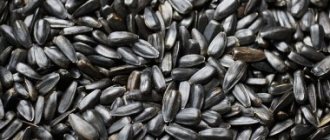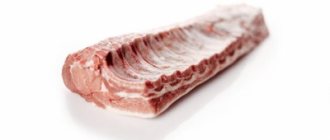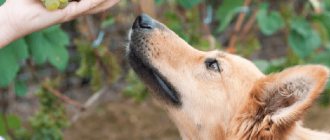Is garlic beneficial or harmful for dogs, what are the consequences of eating a vegetable for an animal, first aid and much more in this article.
Garlic (Allium sativum) belongs to the genus Allium - alliums. This vegetable is valuable because it contains large amounts of organic sulfides - thiosulfides. They determine its smell, taste and bactericidal, anthelmintic effect. In its raw form, it has a very strong effect on the gastrointestinal tract of dogs, especially small breeds. Animals instinctively do not consume this product, as it burns the mucous membranes very strongly. Moreover, if the active base of garlic enters in large quantities directly into the blood, red blood cells begin to suffer, and the trophism (effect of nerves) of tissues is disrupted. Metabolism suffers due to lack of oxygen in the blood. Red blood cells (erythrocytes) lose their antioxidant properties, and the body is depleted. The blood picture is disturbed. In severe cases, we can talk about anemia. The dog loses strength right before our eyes, tries to hide in a dark place, refuses food, loses weight, and this is all a lack of oxygen in the tissues, i.e. hypoxia.
Appearance
| Potassium | an element that participates in metabolic processes and maintains electrolyte balance in the body; |
| Sodium | found in the blood and extracellular fluid, maintains water-salt balance in the body, promotes the normal functioning of the nervous and muscular systems; |
| Magnesium | a microelement that performs very important functions in the body. It is involved in energy production, activates about 600 enzymes in the body, ensures the production of the hormone insulin, protects the heart muscle from overload and ensures muscle function; |
| Iron | responsible for the delivery of oxygen to tissues and organs, the transfer of oxygen dioxide to the lungs, participates in metabolic and physicochemical processes in the body, DNA synthesis; |
| Phosphorus | vital for the normal functioning of the heart, brain, kidneys, and liver. It ensures healthy joints and teeth, and is involved in regulating hormone levels. |
Garlic contains iodine, chlorine, copper, zinc, selenium, manganese, cobalt, as well as vitamins - groups B, C, K, PP and others. But the most important thing is that it contains rare substances that are practically not found in other vegetables and plants. For example, allicin is a natural ester that has antioxidant and antiseptic properties. It is this that gives garlic its pungent taste and specific smell and ensures an increase in the body’s protective functions during seasonal infections.
Allicin blocks the production of enzymes that facilitate the penetration of viruses into the body, and the protein contained in the spicy plant controls the production of antibodies, which pose an insurmountable barrier to pathogenic microorganisms, preventing infection from affecting the body.
Garlic has a beneficial effect on the digestive system. It increases appetite, helps digest heavy foods, increases bile production and reduces liver fat cells. Eating garlic helps reduce bad cholesterol levels, thereby reducing the risk of developing cardiovascular diseases.
Garlic prevents blood clots and protects the body from cancer. Allicin prevents cancer cells from multiplying and spreading. It also suppresses the growth of pathogenic microorganisms - it destroys salmonella, Staphylococcus aureus, and E. coli.
Important!
Garlic increases the body's endurance and increases performance.
And yet, what is useful for a person can be harmful for a dog. Therefore, veterinarians do not recommend adding garlic and other spices to pet food.
Breed exceptions
Unfortunately, there are no breed exceptions. All dogs are exposed to garlic toxins in some way.
However, large breeds tolerate poisoning more easily, recover faster, and have a lower risk of developing serious complications. Small breeds, due to their size, are at greater risk - a few grams are enough for them to be seriously poisoned.
It has been noted that dogs of Japanese breeds, such as Shiba Inu and Akita Inu, show increased sensitivity to toxins from plants of the Onion genus. Garlic is strictly contraindicated for representatives of these breeds.
Harm of garlic
There are many unfortunate dog breeders who, claiming that garlic has unique anthelmintic properties, can be given to their pet without fear. Veterinarians do not share such enthusiasm. Since garlic does much more harm than good, and it is best to rid an animal of parasites using proven and safe products, which are sold in a wide range in veterinary pharmacies and pet stores.
You should not use garlic to repel fleas and ticks from your pet, as some dog owners do. This smell is very unpleasant for an animal, it can cause a disturbance in the sense of smell and causes discomfort, and negatively affects the pet’s nervous system.
But the most important thing is that taking garlic internally irritates the mucous membrane of the esophagus and stomach, and if such a “medicine for worms” is given to the dog regularly, you can observe the development of gastritis, inflammatory processes in the organs of the digestive system, which are accompanied by pain in the abdomen. A complication of gastritis can be a peptic ulcer, and the pet will have to undergo treatment for a long time.
On the second to fourth day of feeding your pet garlic, signs of poisoning may appear. Intoxication may be indicated by:
- vomit;
- dyspnea;
- cardiopalmus;
- weakness;
- increased breathing;
- increased salivation and other signs.
Poisoning can be caused by thiosulfate, a toxic substance contained in garlic. It has the ability to cause the destruction of red blood cells. The pathology is called hemolytic anemia and is characterized by weakness, rapid pulse, and impaired respiratory function. The root vegetable can cause significant harm to the pet’s body, negatively affecting brain function: brain activity decreases, and sometimes the pet’s behavior can become uncontrollable.
Important!
Manufacturers add garlic to some industrial feeds, but these are just extracts from the plant that enrich the feed with beneficial substances and do not contain toxins.
Effect on animals
Garlic belongs to the genus Allium (Onion) - plants such as wild garlic, leeks and onions, which are toxic to animals, belong to the same genus. Strictly speaking, all members of the genus Allium contain toxins. The essential oils of these plants contain allyl propyl sulfide, dipropyl disulfide and other substances similar to them in structure.
These substances have the ability to transform hemoglobin - a special blood protein that binds and transports oxygen - into metahemoglobin, a protein similar in structure to hemoglobin, but does not have the ability to bind oxygen.
The transformation of hemoglobin into metahemoglobin starts the process of destruction of red blood cells. The transport of oxygen to tissues is sharply reduced, which leads to a general deterioration in the condition of the body. In severe cases (for example, with severe intoxication with substances that affect hemoglobin), death is possible.
Substances that oxidize hemoglobin and contribute to the destruction of red blood cells are contained in all plants of the Onion genus without exception, but in varying quantities. Onions contain the most of them, green onions, leeks and garlic contain slightly less.
The relatively low content of toxic substances in garlic explains the fact that, despite its toxicity, it is used in veterinary medicine as an antiparasitic agent.
Complete ban or restriction?
Some veterinarians still allow a minimum amount of garlic in the animal’s food, while reminding that the root vegetable has a sharp, specific smell that can affect the pet’s appetite - the dog may refuse to eat.
If the owner of the animal still believes in the power of folk recipes and the high antiparasitic properties of garlic, then you should know:
- Under no circumstances should it be given to puppies under 2 months of age. Their red blood cell formation system is not fully formed, so such food, even in minimal quantities, can lead to changes in the blood formula;
- Garlic should not be given by adding it to food, but separately - by chopping it and forcing the dog to eat the pulp;
- It is dangerous to give garlic before surgery because it affects heart function, lowers blood pressure, which can be fatal.
Contains special vitamins
Modern manufacturers of food and special vitamins for dogs often add garlic to their products. This is justified by the fact that this plant strengthens the immune system and increases resistance to disease.
Garlic in such foods and preparations is contained in dried form, but this does not reduce its toxicity. Therefore, to avoid unpleasant consequences for your pet’s health, it is better to avoid these types of additives. Therefore, you should not give baby puree to animals - it may also contain onions and garlic in dried form.
Dieffenbachia
Toxic components: insoluble calcium oxalates, proteolytic enzyme
VAITEKUNE/GETTY IMAGES
This tropical indoor plant with a thick stem and large decorative leaves grows very beautiful in low light and has light spots. But it should be kept out of the reach of dogs. The plant contains calcium oxalate crystals that look like microscopic pieces of glass, like needles. Chewing or swallowing Dieffenbachia can cause poisoning in dogs.
Common symptoms include vomiting, swelling of the mouth and/or throat, severe oral pain, sore throat or sore eyes, severe skin irritation, restlessness, cough, vomiting and hypersalivation. Simple contact with the plant can also cause these symptoms. If your dog's eyes and skin are exposed and have a Dieffenbachia burn, immediately rinse with water or bathe the animal.
How is poisoning from grapes, raisins or currants treated?
The goal of treatment is to block the absorption of toxins from the gastrointestinal tract and prevent or minimize kidney damage.
The best treatment is early detoxification of the patient by induction of vomiting and oral administration of absorbents. This helps prevent or minimize the absorption of toxins from the gastrointestinal tract. Since grapes and raisins remain in the stomach for a long period of time, inducing vomiting, if it has not started on its own, is of paramount importance, even 4-6 hours after eating these fruits.
Following detoxification measures, additional treatment may be required, including volumetric intravenous therapy, to remove all absorbed toxins from the body as quickly as possible and help preserve kidney function. Drugs against nausea and vomiting, to maintain renal blood flow and to control blood pressure are prescribed as indicated.
The goal of treatment is to block the absorption of toxins from the gastrointestinal tract and prevent or minimize kidney damage.
It is good if the dog was able to be hospitalized for intravenous therapy within 24-48 hours after ingesting grapes, raisins or currants. Animals with this condition may require hospital treatment for 2-7 days.
During the course of treatment, veterinarians monitor kidney blood levels daily to assess the body's response to treatment and determine whether treatment needs to be intensified. Blood tests also need to be repeated every 2-3 days after your pet returns home to ensure that kidney failure is not progressing.
general information
It is often recommended to give garlic to animals in order to get rid of worms, as well as strengthen the general condition of the body. However, not all so simple. Speaking about whether it is possible to give garlic to dogs, many experts fundamentally disagree with its use. Moreover, they classify garlic as a so-called prohibited food that is not recommended for dogs. This number also includes spices and spicy foods. By and large, garlic can be included in this category.
Veterinarians believe that frequent consumption of this product can lead to serious digestive problems. So how do you figure out whether dogs can have garlic?
How does a veterinarian make a diagnosis?
- At the first suspicion that a dog has been poisoned with onions and/or garlic, the veterinarian must take a blood test. It is important to understand that on the first day a general (clinical) blood test may not show anemia, so blood sampling is repeated later again, especially if the symptoms progress.
- A urine test shows the presence of hemoglobin and bilirubin (hence the specific color).
- An ultrasound will show problems with the kidneys (nephrosis) against the background of hypoxia and increased work to remove destroyed red blood cells. The spleen will be enlarged.
- To unambiguously confirm the diagnosis, the veterinarian excludes parasitic diseases that occur with anemia and destruction of red blood cells: leptospirosis, anaplasmosis, ehrlichiosis and piroplasmosis (babesiosis). Congenital anemia with the destruction of red blood cells is quite rare, so this option is not yet being considered.











